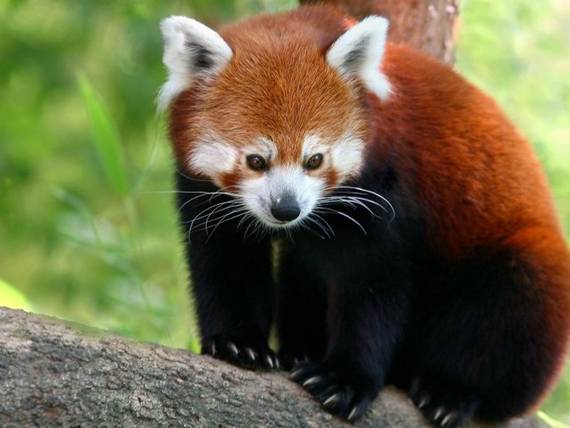
Red panda, or Lesser panda, or Red-cat bear(Ailurus fulgens)
Phylum —chordata
Class — mammalia
Order — carnivora
Family — ailuridae
Genus –ailurus
Appearance
The Red panda has long, soft, reddish-brown fur on the upper parts, blackish fur on the lower parts, and a light face with tear markings and white badges similar to those of a raccoon, but each individual can have distinctive markings. Its skull is roundish with medium-sized upright ears, its nose is black, and its eyes are blackish. Its teeth are robust. Its long, bushy tail with six alternating transverse ochre rings provide balance and excellent camouflage in a habitat with moss- and lichen-covered trees. The legs are black and short with thick fur on the soles of the paws. This fur serves as thermal insulation on snow-covered or icy surfaces and conceals scent glands, which are also present on the anus.
The head and body length of a Red panda measures 50 to 64 cm (20 to 25 in), and its tail is 28 to 59 cm (11 to 23 in) long. Males weigh 3.7 to 6.2 kg (8.2 to 13.7 lb) and females 3 to 6.0 kg (6.6 to 13.2 lb).
Habitat
The range of Red pandas extends from northern Myanmar to western Nepal. It also lives in the mountains of southwestern China (Sichuan, Xizang and Yunnan provinces) at elevations from 4,900 to 13,000 feet.
Behavior
The Red panda is nocturnal and usually solitary. They sleep during the day high up in the tree canopy, wrapping their long, bushy tail around them to keep warm. They feed in the trees but usually descend to the ground when dusk falls to foraging under cover of darkness. It is a territorial animal and marks its patch with urine, droppings, and a musky secretion that comes from its anal glands. Communication between one another is by means of short whistles and squeaks.
Diet
The Red panda belongs to a carnivorous group of mammals, but they mostly east bamboo shoots, so their diet is almost vegetarian. It will eat other foods such as grasses, acorns, and berries, as well as grubs, lizards, mice, chicks and birds' eggs.
Reproduction
Males and females may take more than one partner during a season, which is usually between January and March. After gestation of around 4 months, 1-5 cubs are born. In preparation for the birth, the female constructs a nest inside a tree hollow. After a week, a female will spend more time out of the nest, coming back every few hours to groom and nurse the young, and clean the nest. The young stay in the nest for about 90 days, and are weaned at around 6-8 months old. They first leave the nest at night. The young eat bamboo only until being old enough to digest other foods. They grow to full size in about a year. These pandas can breed from around 18 months old, and are fully sexually mature at 2-3 years.
In captivity
The maximum lifespan of the Red panda is 14 years, but the average is eight to ten.
The Red panda is characterized as peaceful and quiet and easily reproduces in captivity.
Red pandas are kept in spacious enclosures with logs for climbing. A shelter is installed at the top of the enclosure.
When kept in captivity, the Red panda practically does not eat meat. In captivity, they eat leaves and buds, fruits, as well as grass, bamboo buds, rice cooked in milk, and sugar-sweetened milk.
 Russian
Russian
 English
English
























